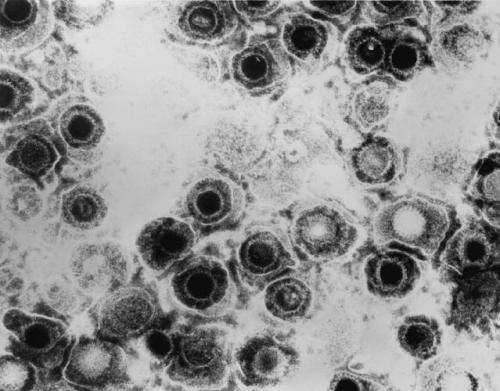
Northwestern Medicine scientists have discovered how herpes viruses hijack cellular transport processes to infiltrate the nervous system, as described in a study published in the Proceedings of the National Academy of Sciences.
It’s estimated that 3.7 billion people globally are infected by herpes simplex virus type 1 (HSV-1), the main cause of oral herpes, according to the World Health Organization. The National Institutes of Health estimates that nearly half of all Americans carry the virus, which hides out in the nervous system and can never be fully eliminated.
While many cases of herpes are asymptomatic, the infection can include painful, recurring blisters or ulcers.
The current study comes after previous findings from the laboratory of Gregory Smith, Ph.D., professor of Microbiology-Immunology, which described how herpes viruses hitch a ride on cellular train tracks called microtubules and use protein engines, dynein and kinesin, to move.
The latest study dives deeper into the molecular mechanisms behind the process, said Smith, senior author of the study.
“We are developing vaccines against these viruses and these vaccines were designed specifically to not get into your nervous system,” Smith said. “We knew how to mutate them so they didn’t get to the nervous system. But we didn’t have a complete understanding mechanistically of why our mutations were so effective.”
In the current study, investigators used time-lapse fluorescence imaging to track the herpes virus in infected nerve cells. They found that the viral protein pUL37 worked to suppress kinesin hijacked from healthy cells to fuel the virus’ movement into nerves.
The virus was able to keep its kinesin motor turned off until just the right moment when it effectively infiltrated the nerve, and then used the motor to fast-track to the nucleus of the neuron, according to the study.
When Smith and his collaborators artificially activated the motor protein before the virus reached the inner parts of its target cell, it prevented the virus from sneaking into the nervous system.
“Our findings demonstrate how alphaherpesviruses, such as HSV-1, evolved to become highly efficient at invading the nervous system,” said DongHo Kim, first author of the study and a Ph.D. student in the Smith laboratory.
“The virus achieves this by spatially and temporally regulating the kinesin motor protein to allow smooth delivery of viral particles to the nucleus. Failure to regulate the kinesin motor will cause it to engage in a tug-of-war with the opposing dynein motor, and the virus fails to move towards one direction or another.”
“I think our model adds a significant step in understanding the neuro-invasion process by HSV-1, and I am personally excited to see how we can use this machinery for potential therapies,” Kim said.
Moving forward, Smith’s lab will continue to study how the virus uses motor proteins to travel inside its host and how inhibiting kinesin affects viral infiltration, Smith said.
“With this new understanding, we can now dive deeper into this choreographed process that delivers viral genetic material from the outside world into our neurons,” Smith said.
More information:
DongHo Kim et al, The HSV-1 pUL37 protein promotes cell invasion by regulating the kinesin-1 motor, Proceedings of the National Academy of Sciences (2024). DOI: 10.1073/pnas.2401341121
Citation:
How herpes hijacks a ride into cells (2024, May 10)
herpes-hijacks-cells.html
.
. The content is provided for information purposes only.
